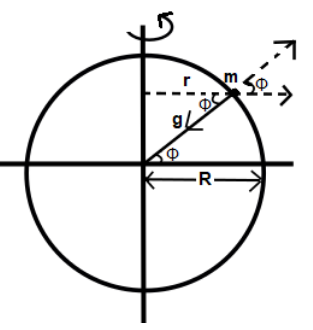
The speed of Earth’s rotation about its axis is $\varpi $ . Its speed is increased to $x$ times to make the effective acceleration due to gravity equal to zero at the equator, then $x$ is around ($g=10m{{s}^{-2}},R=6400km$)
A. $1$
B. $8.5$
C. $17$
D. $34$
Answer
506.1k+ views
Hint:Here we will clear our concept related to variation of gravitational force in difference in latitude. We will know which force will be acting on Earth. Earth is under the influence of centripetal and centrifugal force as it rotates on its own axis.
Complete answer:
The centripetal and centrifugal force come in picture when an object is in circular motion and so is our Earth. Let us consider a body of mass $m$ at the latitude, which makes an angle $\phi $ at the center of the Earth. Now, as Earth rotates on its axis, then mass m will also rotate and form a circle about the axis of rotation.
And, as the body rotates in a circular motion then, there is a centrifugal force which acts outside away from the center of the circle. Hence the effective gravity will be $g'=g-{{\varpi }^{2}}R{{\cos }^{2}}\phi $. When the body is at equator, $\cos \phi =\cos 0=1$ thus the net acceleration will be $g'=g-{{\varpi }^{2}}R$

We know that Earth takes 24 hours to rotate about its own axis. So,
$T=24\times 60\times 60\,s$
Angular speed of Earth about its own axis will be:
$\varpi =\dfrac{2\pi }{T}=\dfrac{2\pi }{24\times 60\times 60}rad{{s}^{-1}}$
At equator, $g'=g-{{R}_{e}}^{2}g'=g-{{R}_{e}}\varpi {{'}^{2}}$ or $0=g-{{R}_{e}}\varpi {{'}^{2}}$
So, $\varpi '=\sqrt{\dfrac{g}{{{R}_{e}}}}=\dfrac{2\pi }{84.6\times 60}$
When we take their ratio we get
$\dfrac{\varpi '}{\varpi }=\dfrac{24\times 60\times 60}{84.6\times 60}\approx 17$
$\therefore \varpi '=17\varpi $
Hence, the correct answer is option C.
Note: One must know that when the body is placed at pole the angle between center of Earth and the body will be $\phi =90{}^\circ $$\Rightarrow \cos \phi =\cos 90=0$, therefore the effective gravity will be $g'=g$. Hence, we have the maximum gravitational acceleration at the poles and minimum at the equator.
Complete answer:
The centripetal and centrifugal force come in picture when an object is in circular motion and so is our Earth. Let us consider a body of mass $m$ at the latitude, which makes an angle $\phi $ at the center of the Earth. Now, as Earth rotates on its axis, then mass m will also rotate and form a circle about the axis of rotation.
And, as the body rotates in a circular motion then, there is a centrifugal force which acts outside away from the center of the circle. Hence the effective gravity will be $g'=g-{{\varpi }^{2}}R{{\cos }^{2}}\phi $. When the body is at equator, $\cos \phi =\cos 0=1$ thus the net acceleration will be $g'=g-{{\varpi }^{2}}R$

We know that Earth takes 24 hours to rotate about its own axis. So,
$T=24\times 60\times 60\,s$
Angular speed of Earth about its own axis will be:
$\varpi =\dfrac{2\pi }{T}=\dfrac{2\pi }{24\times 60\times 60}rad{{s}^{-1}}$
At equator, $g'=g-{{R}_{e}}^{2}g'=g-{{R}_{e}}\varpi {{'}^{2}}$ or $0=g-{{R}_{e}}\varpi {{'}^{2}}$
So, $\varpi '=\sqrt{\dfrac{g}{{{R}_{e}}}}=\dfrac{2\pi }{84.6\times 60}$
When we take their ratio we get
$\dfrac{\varpi '}{\varpi }=\dfrac{24\times 60\times 60}{84.6\times 60}\approx 17$
$\therefore \varpi '=17\varpi $
Hence, the correct answer is option C.
Note: One must know that when the body is placed at pole the angle between center of Earth and the body will be $\phi =90{}^\circ $$\Rightarrow \cos \phi =\cos 90=0$, therefore the effective gravity will be $g'=g$. Hence, we have the maximum gravitational acceleration at the poles and minimum at the equator.
Recently Updated Pages
Why are manures considered better than fertilizers class 11 biology CBSE

Find the coordinates of the midpoint of the line segment class 11 maths CBSE

Distinguish between static friction limiting friction class 11 physics CBSE

The Chairman of the constituent Assembly was A Jawaharlal class 11 social science CBSE

The first National Commission on Labour NCL submitted class 11 social science CBSE

Number of all subshell of n + l 7 is A 4 B 5 C 6 D class 11 chemistry CBSE

Trending doubts
What is meant by exothermic and endothermic reactions class 11 chemistry CBSE

10 examples of friction in our daily life

One Metric ton is equal to kg A 10000 B 1000 C 100 class 11 physics CBSE

1 Quintal is equal to a 110 kg b 10 kg c 100kg d 1000 class 11 physics CBSE

Difference Between Prokaryotic Cells and Eukaryotic Cells

What are Quantum numbers Explain the quantum number class 11 chemistry CBSE




